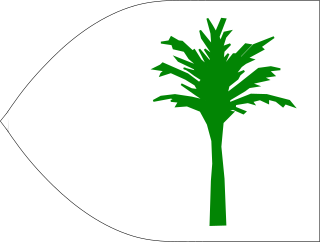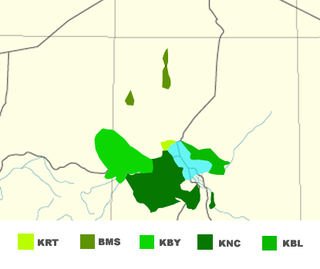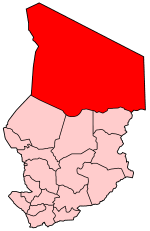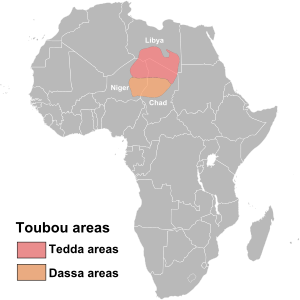
The Kanem–Bornu Empire existed in areas which are now part of Nigeria, Niger, Cameroon, Libya and Chad. It was known to the Arabian geographers as the Kanem Empire from the 8th century AD onward and lasted as the independent kingdom of Bornu until 1900.

Kanuri is a dialect continuum spoken in Nigeria, Niger, Chad and Cameroon, as well as by small minorities in southern Libya and by a diaspora in Sudan.

Daza is a Nilo-Saharan language spoken by the Daza people inhabiting northern Chad. The Daza are also known as the Gouran (Gorane) in Chad. Dazaga is spoken by around 380,000 people, primarily in the Djurab Desert region and the Borkou region, locally called Haya or Faya-Largeau northern-central Chad, the capital of the Dazaga people. Dazaga is spoken in the Tibesti Mountains of Chad, in eastern Niger near N'guigmi and to the north. It is also spoken to a smaller extent in Libya and in Sudan, where there is a community of 3,000 speakers in the city of Omdurman. There's also a small diaspora community working in Jeddah, Saudi Arabia.

The Saharan languages are a small family of languages across parts of the eastern Sahara, extending from northwestern Darfur to southern Libya, north and central Chad, eastern Niger and northeastern Nigeria. Noted Saharan languages include Kanuri, Daza, Teda, and Zaghawa. They are a part of the proposed Nilo-Saharan family.

Mochica is an extinct language formerly spoken along the northwest coast of Peru and in an inland village. First documented in 1607, the language was widely spoken in the area during the 17th century and the early 18th century. By the late 19th century, the language was dying out and spoken only by a few people in the village of Etén, in Chiclayo. It died out as a spoken language around 1920, but certain words and phrases continued to be used until the 1960s.

The Teda language, also known as Tedaga, is a Nilo-Saharan language spoken by the Teda, a northern subgroup of the Toubou people that inhabits southern Libya, northern Chad and eastern Niger.

Camilo Daza International Airport is an international airport located in Cúcuta, Colombia. It serves the Norte de Santander Department.

The Toubou or Tubu are an ethnic group native to the Tibesti Mountains that inhabit the central Sahara in northern Chad, southern Libya and northeastern Niger. They live either as herders and nomads or as farmers near oases. Their society is clan-based, with each clan having certain oases, pastures and wells.

Tianjin Jinmen Tiger Football Club is a professional Chinese football club that currently participates in the Chinese Super League under licence from the Chinese Football Association (CFA). The team is based in Tianjin, and their home stadium is the TEDA Football Stadium, with a seating capacity of 36,390. The founding owners of the team are TEDA Holding, a state-owned conglomerate of the People's Republic of China.
The word Tebu can refer to

The Borkou-Ennedi-Tibesti (BET) was until 2008 one of the then 18 regions of Chad, its capital being Faya-Largeau. It comprised the former Borkou-Ennedi-Tibesti Prefecture. Most of the region was part of the Sahara desert.

Afghanistan is a linguistically diverse nation, with upwards of 40 distinct languages. However, Dari and Pashto are two of the most prominent languages in the country, and have shared official status under various governments of Afghanistan. Dari, as a shared language between multiple ethnic groups in the country, has served as a historical Lingua Franca between different linguistic groups in the region and is the most widely understood language in the country. Pashto is also widely spoken in the region; but the language does not have a diverse multi-ethnic population like Dari, and the language is not as commonly spoken by non-Pashtuns. Dari and Pashto are also "relatives", as both are Iranian languages.

Niger has 11 national languages, with French being the official language and Hausa the most spoken language. Depending on how they are counted, Niger has between 8 and 20 indigenous languages, belonging to the Afroasiatic, Nilo-Saharan and Niger–Congo families. The discrepancy comes from the fact that several are closely related, and can be grouped together or considered apart.

Karai-Karai is a language spoken in West Africa, most prominently North eastern Nigeria. The number of speakers of Karai-Karai is estimated between 1,500,000 to 1,800,000 million, primarily spoken by the ethnic Karai-Karai people. It is an Afro-Asiatic language spoken principally in Nigeria with communities in Bauchi State, Yobe State, Gombe State and other parts of Nigeria. Many Karai-Karai words share a common origin with the Northwest Semitic languages of Hebrew and Arabic. Karai-Karai language is most closely related to the Ngamo and Bole languages which are both considered derivatives of the Karai-Karai language.
Daza or Dazawa is listed by Blench (2006) as a Chadic language within the Bole group, spoken in a few villages of Darazo LGA, Bauchi State, Nigeria. It was confirmed to exist in 2021.

TEDA Modern Guided Rail Tram is a Translohr Light Rail line in Tianjin Economic-Technological Development Area (TEDA). It is a modern, high-speed rubber-tyred tram line, both first in China and Asia. The line is considered as part of the Tianjin Metro system. It is run by Tianjin Binhai Mass Transit Development Co., Ltd, which has been a subsidiary of Tianjin Rail Transit Group Corporation since 2017.
Teda or TEDA may refer to:

The official language of Libya is Modern Standard Arabic. Most residents speak one of the varieties of Arabic as a first language, most prominently Libyan Arabic, but also Egyptian Arabic and Tunisian Arabic.

Tuareg militias of Ghat (TMG) are ethnic Tuareg tribal militias, operating in South-West Libya desert areas during the Second Libyan Civil War. The militias rose to prominence in the district of Ghat, which has a Tuareg majority. Gradually, the Tuareg forces expanded their hold also into neighbouring districts. The Libyan Tuaregs are supported by Tuaregs of Mali and groups like Ahmed al-Ansari, with support from the Misratan Libyan Dawn forces. Tuareg militias often utilize the Berber flag.















